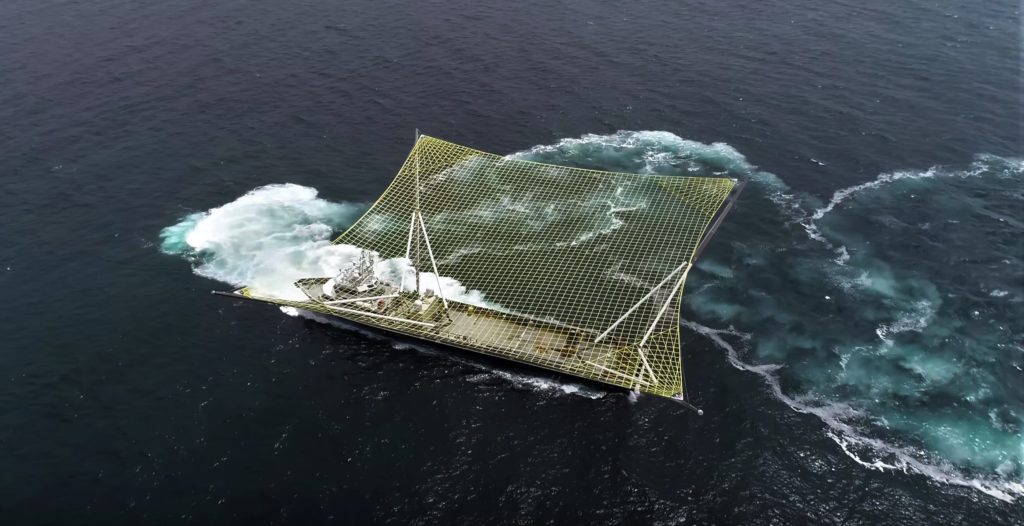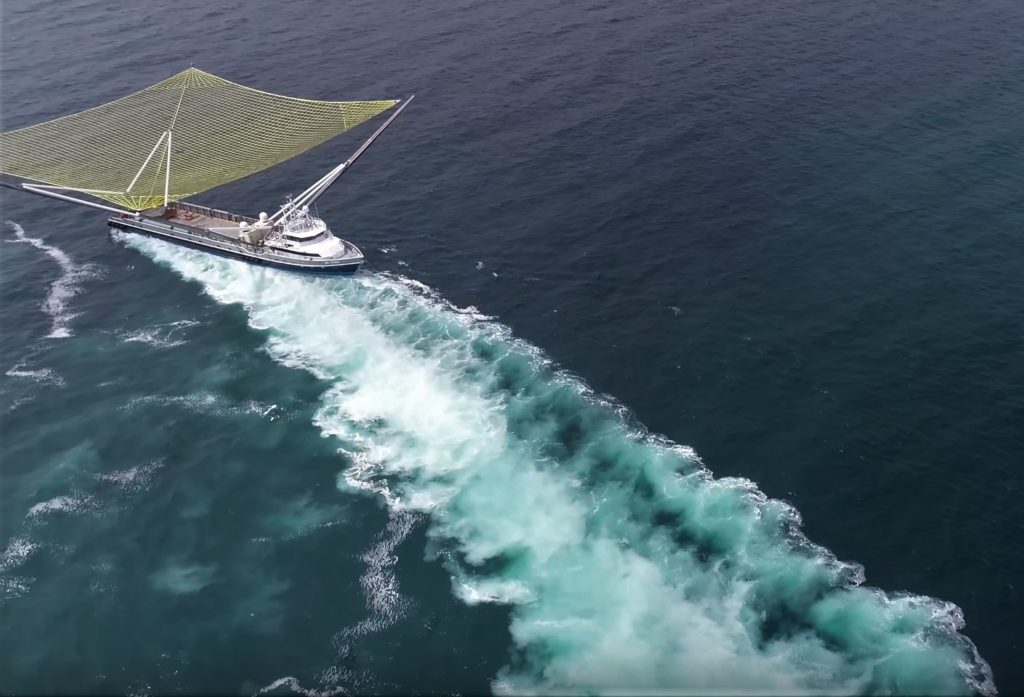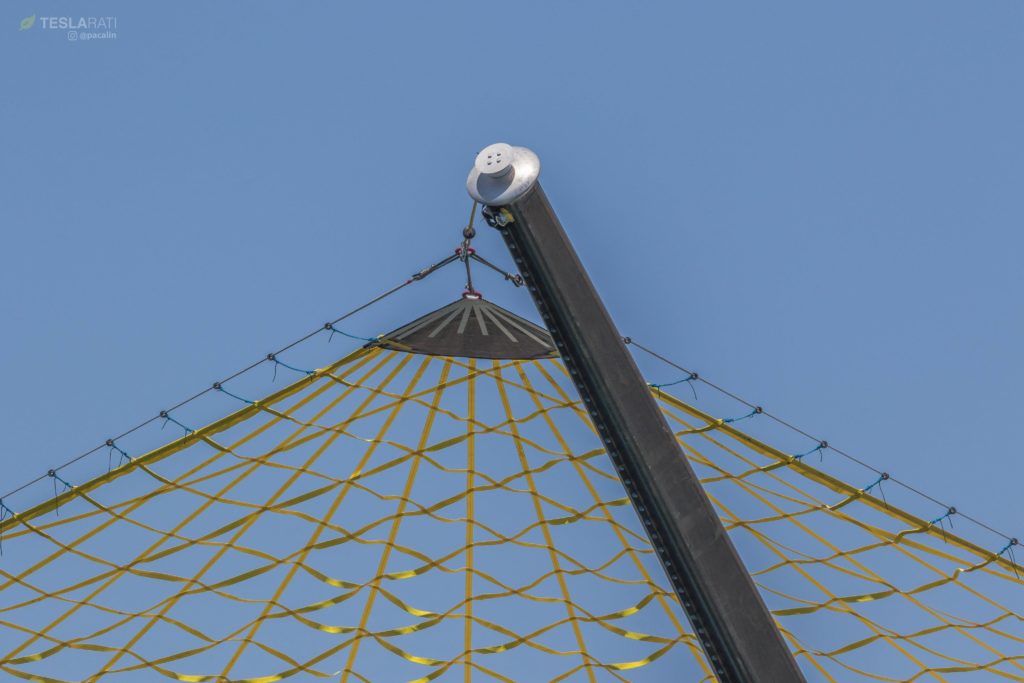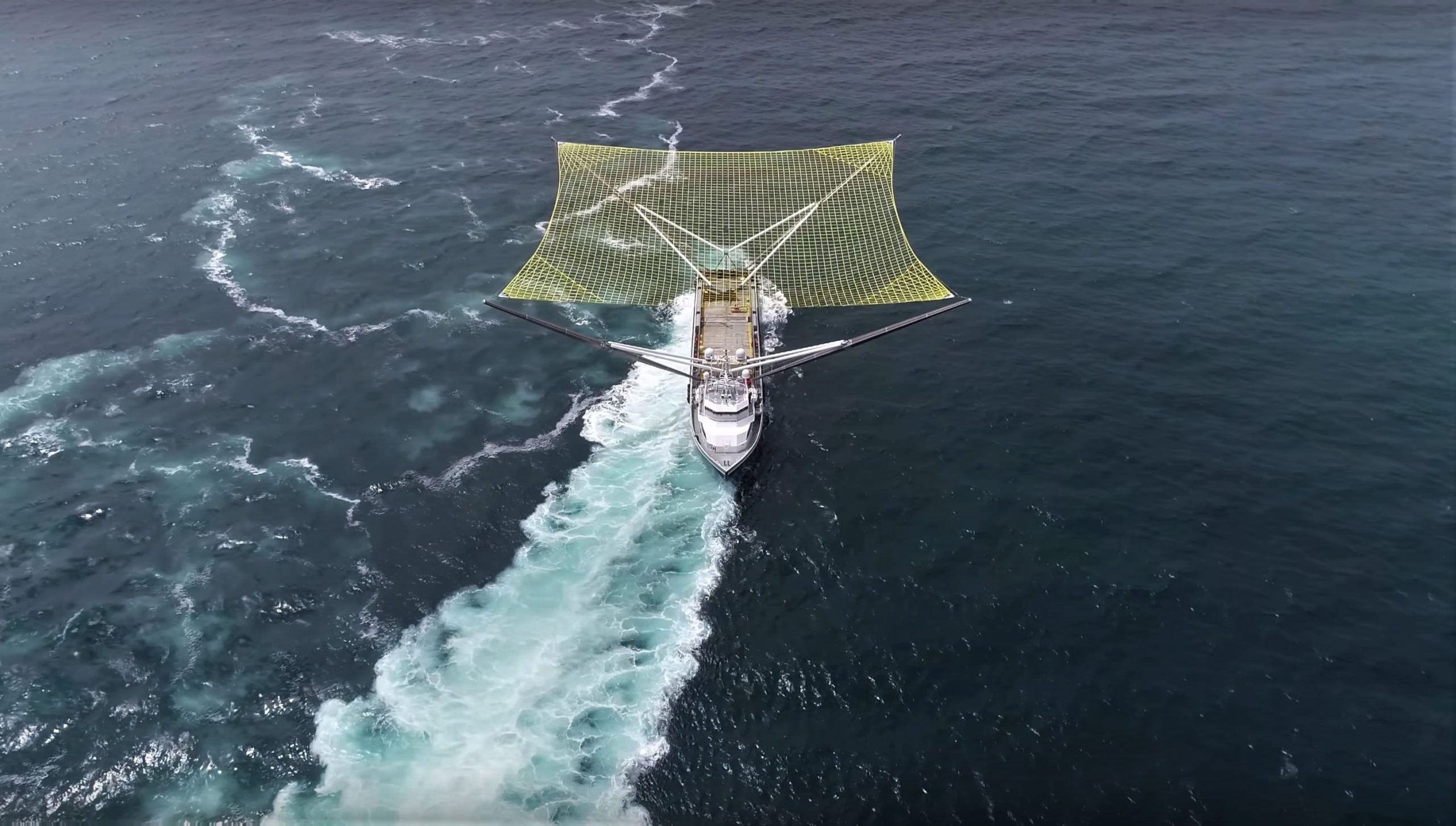
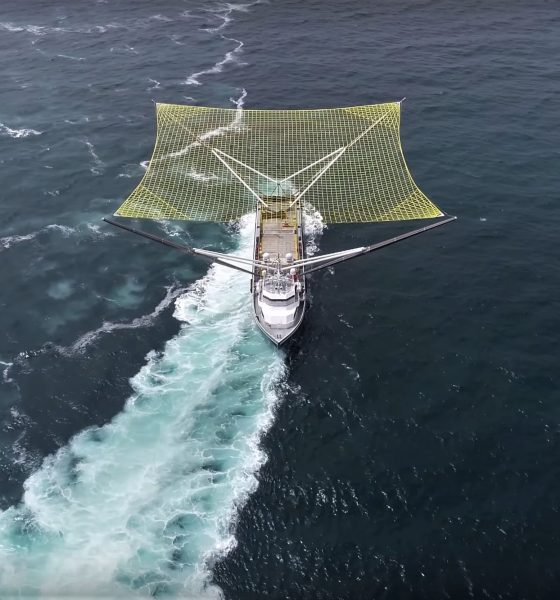
News
SpaceX’s Mr Steven spotted in high-speed test at sea with upgraded net
SpaceX’s newly-outfitted recovery vessel Mr Steven was recently captured conducting aggressive maneuvers off the coast of Port of Los Angeles, just days after the vessel’s massive new arms and net were installed for the first time. The intense pace of upgrades and acceptance testing confirm beyond any reasonable doubt that SpaceX does not intend to waste its next Falcon 9 fairing recovery attempt, set to accompany the July 25th launch of Iridium-7.
The iconic fairing recovery vessel has – for the past three or four weeks – been undergoing major upgrades to its arms or claws, as well as a massive, new net spanning nearly 0.9 acres (3700 m²). With what appears to be a genuine fourfold increase in usable area for fairing recoveries, SpaceX likely has a very strong chance of actually pulling off its first successful catches and reuses of Falcon 9 payload farings, valued at roughly 5% of the rocket’s cost ($3 million per a $60 million base price) per half. Manufacturing cost and price to the customer are difficult to compare, but it at least offers a hint of the full cost of each ~800 kg segment of carbon fiber and aluminum honeycomb.

Mr Steven seen just after a day spent conducting sea-trials a few miles offshore, July 14. (Pauline Acalin)
Based on photos and video captured between July 12 and 15, Mr Steven’s crew and recovery technicians appeared to waste no time at all leaping from arm and net installation to sea-trials of the new hardware at least as extreme as anything previously observed from the SpaceX-leased vessel. Less than half an hour after leaving the harbor for the first time since his massive new arms arrived, Marinetraffic tracking data showed that Mr Steven was already performing aggressive turns and sprints at speeds up to 20 knots (~25 mph), fairly impressive given the vessel’s 200 foot (62 meter) length and gross weight of nearly 200,000 pounds (82,000 kg).
While this may seem impressive, Mr Steven is a class of ship known as a Fast Supply Vessel (FSV) designed to routinely transport a full 400 metric tons of cargo on its deck at cruising speeds of 23 knots (27 mph), which means that the only thing Mr Steven’s wildly expansive arms likely challenge is the vessel’s center of gravity (balance), hence the follow-up tests with hard turns at high speed.
Also of interest, an extraordinary video of some of that testing – unofficially captured, somehow, by drone – showed the ship aggressively maneuvering in reverse, an ability that could come in useful during recovery attempts if the expanded net’s coincidental protection of Mr Steven’s cockpit means that it can become a less fixed element, actively seeking out falling fairings to help close the gap on each parasailing half’s 50 meter error margin.
- Mr Steven makes some serious waves, using his pod thrusters to strafe backwards at 5-10 knots. (anonymous)
- It’s subtle, but a small plus sign appears to ‘mark the spot’ on Mr Steven’s new net, stretching roughly 60×60 meters. (anonymous)
- Mr Steven shows off the fancy new rigging of that upgraded net. (Pauline Acalin)
Another opportunity fast approaches
Previously scheduled for July 20, Iridium’s NEXT 7 multi-satellite launch was pushed back a handful of days to July 25 to give SpaceX engineers and technicians additional time to prepare what is the company’s third Block 5 Falcon 9 to roll off its Hawthorne, CA assembly line. While suboptimal for the customer and for SpaceX’s manifest, that slight delay very likely padded slim schedule margins for Mr Steven’s major arm upgrades, meaning that the vessel will now be able to participate in the imminent launch’s recovery operations. After the first flightworthy vehicle’s debut in May 2018, SpaceX’s rocket production has ramped up in quite an extreme fashion, jumping from four first stages produced in six months to another three or four boosters completed and tested in Texas in just two months.
While the transportation of Falcon fairings and upper stages is far harder to keep track of, production of those critical components of the rocket have also reached throughput levels that are new territory for SpaceX, including an impressive statistic of an average of one full Merlin 1D rocket engine manufactured daily according to an individual with experience on the factory floor.
The Block 5 iteration of the workhorse SpaceX vehicle is in many ways a wholly new rocket, featuring an array of upgrades that include new heat shielding at the rocket’s base, interstage, and legs; retractable landing legs, upgraded Merlin 1D engines, and a clean-sweep refresh of the vehicle’s avionics, to name just a handful of the major changes included.

SpaceX technicians wrench on a trio of varied Merlin 1Ds in McGregor, Texas, where every single engine is test-fired before being attached to a Falcon 9. (SpaceX)
Follow us for live updates, peeks behind the scenes, and photos from Teslarati’s East and West Coast photographers.
Teslarati – Instagram – Twitter
Tom Cross – Twitter
Pauline Acalin – Twitter
Eric Ralph – Twitter

News
Tesla Diner becomes latest target of gloom and doom narrative

The Tesla Diner has been subject to many points of criticism since its launch in mid-2025, and skeptics and disbelievers claim the company’s latest novel concept is on its way down, but there’s a lot of evidence to state that is not the case.
The piece cites anecdotal evidence like empty parking lots, more staff than customers during a December visit, removed novelty items, like Optimus robot popcorn service and certain menu items, the departure of celebrity chef Eric Greenspan in November 2025, slow service, high prices, and a shift in recent Google/Yelp reviews toward disappointment.
The piece frames this as part of broader Tesla struggles, including sales figures and Elon Musk’s polarizing image, calling it a failed branding exercise rather than a sustainable restaurant.
This narrative is overstated and sensationalized, and is a good representation of coverage on Tesla by today’s media.
Novelty Fade is Normal, Not Failure
Any hyped launch, especially a unique Tesla-branded destination blending dining, Supercharging, and a drive-in theater, naturally sees initial crowds taper off after the “Instagram effect” wears down.
Tesla makes major change at Supercharger Diner amid epic demand
This is common for experiential spots in Los Angeles, especially pop-up attractions or celebrity-backed venues. The article admits early success with massive lines and social media buzz, but treats the return to normal operations as “dying down.”
In reality, this stabilization is a healthy sign of transitioning from hype-driven traffic to steady patronage.
Actual Performance Metrics Contradict “Ghost Town” Claims
- In Q4 2025, the Diner generated over $1 million in revenue, exceeding the average McDonald’s location
- It sold over 30,000 burgers and 83,000 fries in that quarter alone. These figures indicate a strong ongoing business, especially for a single-location prototype focused on enhancing Supercharger experiences rather than competing as a mass-market chain
It’s not a ghost town lol. The @Tesla Diner still had over 30,000 burger orders and 83,000 fries orders in Q4. The diner generated over $1M in revenue in Q4, a $4M annual run rate, which is more than the average McDonald’s…. pic.twitter.com/XvAGLUqxej
— Sawyer Merritt (@SawyerMerritt) January 4, 2026
Conflicting On-the-Ground Reports
While the article, and other similar pieces, describe a half-full parking lot and sparse customers during specific off-peak visits, other recent accounts push back:
- A January 2026 X post noted 50 of 80 Supercharger stalls were busy at 11 a.m., calling it “the busiest diner in Hollywood by close to an order of magnitude
TESLA DINER 🍔
Frantic!!!
Crazy busy. pic.twitter.com/wMbmr8SFFn
— Rich & Sharon (@HullTeslaModel3) January 4, 2026
- Reddit discussions around the same time describe it as not empty when locals drive by regularly, with some calling the empty narrative “disingenuous anti-Tesla slop.”
When we visited it last week it was packed. We had to wait to enter, get a table and go to the restroom. We were lucky to find a spot to charge.
— Rani G (@ranig) January 4, 2026
Bottom Line
The Tesla Diner, admittedly, is not the nonstop circus it was at launch–that was never sustainable or intended. But, it’s far from “dying” or an “empty pit stop.”
It functions as a successful prototype: boosting Supercharger usage, generating solid revenue, and serving as a branded amenity in the high-traffic EV market of Los Angeles.
News
Tesla stands to win big from potential adjustment to autonomous vehicle limitations
Enabling scale, innovation, and profitability in a sector that is growing quickly would benefit Tesla significantly, especially as it has established itself as a leader.

Tesla stands to be a big winner from a potential easing of limitations on autonomous vehicle development, as the United States government could back off from the restrictions placed on companies developing self-driving car programs.
The U.S. House Energy and Commerce subcommittee will hold a hearing later this month that will aim to accelerate the deployment of autonomous vehicles. There are several key proposals that could impact the development of self-driving cars and potentially accelerate the deployment of this technology across the country.
These key proposals include raising the NHTSA’s exemption cap from 2,500 to 90,000 vehicles per year per automaker, preempting state-level regulations on autonomous vehicle systems, and mandating NHTSA guidelines for calibrating advanced driver assistance systems (ADAS).
Congress, to this point, has been divided on AV rules, with past bills like the 2017 House-passed measure stalling in the Senate. Recent pushes come from automakers urging the Trump administration to act faster amid competition from Chinese companies.
Companies like Tesla, who launched a Robotaxi service in Austin and the Bay Area last year, and Alphabet’s Waymo are highlighted as potential beneficiaries from lighter sanctions on AV development.
The NHTSA recently pledged to adopt a quicker exemption review for autonomous vehicle companies, and supporters of self-driving tech argue this will boost U.S. innovation, while critics are concerned about safety and job risks.
How Tesla Could Benefit from the Proposed Legislation
Tesla, under CEO Elon Musk’s leadership, has positioned itself as a pioneer in autonomous driving technology with its Full Self-Driving software and ambitious Robotaxi plans, including the Cybercab, which was unveiled in late 2024.
The draft legislation under consideration by the U.S. House subcommittee could provide Tesla with significant advantages, potentially transforming its operational and financial landscape.
NHTSA Exemption Cap Increase
First, the proposed increase in the NHTSA exemption cap from 2,500 to 90,000 vehicles annually would allow Tesla to scale up development dramatically.
Currently, regulatory hurdles limit how many fully autonomous vehicles can hit the roads without exhaustive approvals. For Tesla, this means accelerating the rollout of its robotaxi fleet, which Musk envisions as a network of millions of vehicles generating recurring revenue through ride-hailing. With Tesla’s vast existing fleet of over 6 million vehicles equipped with FSD hardware, a higher cap could enable rapid conversion and deployment, turning parked cars into profit centers overnight.
Preempting State Regulations
A united Federal framework would be created if it could preempt State regulations, eliminating the patchwork of rules that currently complicate interstate operations. Tesla has faced scrutiny and restrictions in states like California, especially as it has faced harsh criticism through imposed testing limits.
A federal override of State-level rules would reduce legal battles, compliance costs, and delays, allowing Tesla to expand services nationwide more seamlessly.
This is crucial for Tesla’s growth strategy, as it operates in multiple markets and aims for a coast-to-coast Robotaxi network, competing directly with Waymo’s city-specific expansions.
Bringing Safety Standards to the Present Day
Innovation in the passenger transportation sector has continued to outpace both State and Federal-level legislation, which has caused a lag in the development of many things, most notably, self-driving technology.
Updating these outdated safety standards, especially waiving requirements for steering wheels or mirrors, directly benefits Tesla’s innovative designs. Tesla wanted to ship Cybertruck without side mirrors, but Federal regulations required the company to equip the pickup with them.
Cybercab is also planned to be released without a steering wheel or pedals, and is tailored for full autonomy, but current rules would mandate human-ready features.
Streamlined NHTSA reviews would further expedite approvals, addressing Tesla’s complaints about bureaucratic slowdowns. In a letter written in June to the Trump Administration, automakers, including Tesla, urged faster action, and this legislation could deliver it.
In Summary
This legislation represents a potential regulatory tailwind for Tesla, but it still relies on the government to put forth action to make things easier from a regulatory perspective. Enabling scale, innovation, and profitability in a sector that is growing quickly would benefit Tesla significantly, especially as it has established itself as a leader.
News
Nvidia CEO Jensen Huang explains difference between Tesla FSD and Alpamayo
“Tesla’s FSD stack is completely world-class,” the Nvidia CEO said.

NVIDIA CEO Jensen Huang has offered high praise for Tesla’s Full Self-Driving (FSD) system during a Q&A at CES 2026, calling it “world-class” and “state-of-the-art” in design, training, and performance.
More importantly, he also shared some insights about the key differences between FSD and Nvidia’s recently announced Alpamayo system.
Jensen Huang’s praise for Tesla FSD
Nvidia made headlines at CES following its announcement of Alpamayo, which uses artificial intelligence to accelerate the development of autonomous driving solutions. Due to its focus on AI, many started speculating that Alpamayo would be a direct rival to FSD. This was somewhat addressed by Elon Musk, who predicted that “they will find that it’s easy to get to 99% and then super hard to solve the long tail of the distribution.”
During his Q&A, Nvidia CEO Jensen Huang was asked about the difference between FSD and Alpamayo. His response was extensive:
“Tesla’s FSD stack is completely world-class. They’ve been working on it for quite some time. It’s world-class not only in the number of miles it’s accumulated, but in the way it’s designed, the way they do training, data collection, curation, synthetic data generation, and all of their simulation technologies.
“Of course, the latest generation is end-to-end Full Self-Driving—meaning it’s one large model trained end to end. And so… Elon’s AD system is, in every way, 100% state-of-the-art. I’m really quite impressed by the technology. I have it, and I drive it in our house, and it works incredibly well,” the Nvidia CEO said.
Nvidia’s platform approach vs Tesla’s integration
Huang also stated that Nvidia’s Alpamayo system was built around a fundamentally different philosophy from Tesla’s. Rather than developing self-driving cars itself, Nvidia supplies the full autonomous technology stack for other companies to use.
“Nvidia doesn’t build self-driving cars. We build the full stack so others can,” Huang said, explaining that Nvidia provides separate systems for training, simulation, and in-vehicle computing, all supported by shared software.
He added that customers can adopt as much or as little of the platform as they need, noting that Nvidia works across the industry, including with Tesla on training systems and companies like Waymo, XPeng, and Nuro on vehicle computing.
“So our system is really quite pervasive because we’re a technology platform provider. That’s the primary difference. There’s no question in our mind that, of the billion cars on the road today, in another 10 years’ time, hundreds of millions of them will have great autonomous capability. This is likely one of the largest, fastest-growing technology industries over the next decade.”
He also emphasized Nvidia’s open approach, saying the company open-sources its models and helps partners train their own systems. “We’re not a self-driving car company. We’re enabling the autonomous industry,” Huang said.
